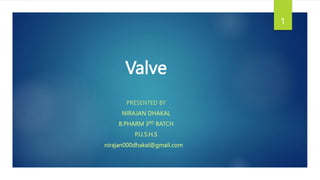
Valve.pptx
- 1. Valve PRESENTED BY NIRAJAN DHAKAL B.PHARM 3RD BATCH P.U.S.H.S 1 nirajan000dhakal@gmail.com
- 2. Contents Introduction 3-4 Reason for using valve 5 Types of valve 6 • Ball Valve 7 • Butterfly Valve 8 • Globe Valve 9 • Gate Valve 10 • Diaphragm Valve 11 • Plug Valve 12 2
- 3. Introduction Valves are essential components of piping systems, which regulate the flow of fluids, such as water, gas, and oil. They are used to start, stop, and control the flow of fluids in a piping system. Valves come in different types, including ball valves, gate valves, globe valves, butterfly valves, and check valves, each designed for specific applications A valve is a mechanical device that controls the flow of fluids (liquids, gases, or slurries) by opening, closing, or partially obstructing various passageways through a piping system. A valve is a generic name for device with a movable feature that opens and closes the passageway in order to allow, prevent or control the flow of fluids. 3
- 4. Valve Body: Usually metallic or plastic Stem: Transmit motion from handle or controlling device, may be linear, rotatory combination of those. Bonnet: Optional part, used to simplify cleaning Plug: Device to control flow rate 4
- 5. Reason for using valves: To restrict, control, and stop the flow of liquid. They are found virtually in all industrial process including water and sewage processing, mining, power generation, processing of oil gas and petroleum. In nature there are valves, for example one-way valves in veins controlling the blood circulation, and heart valves controlling the flow of blood in the chambers of the heart and maintaining the correct pumping action. Valves may be operated manually, either by a handle , lever, pedal or wheel. Valves may also be automatic, driven by changes in pressure, temperature, or flow. These changes may act upon a diaphragm or a piston which in turn activates the valve, examples of this type of valve found commonly are safety valves fitted to hot water systems or boilers. 5
- 6. Types of valve Based on their working mechanism, valves are divided into different types: • Ball Valve • Butterfly Valve • Globe Valve • Gate Valve • Diaphragm Valve • Plug Valve 6
- 7. Ball Valve It uses hollow, perforated and pivoting ball to control fluid. It opens when balls hole is in line to flow and closed when the opening is perpendicular. Advantage: Ease of repair, operation, and versatility Disadvantage: Lack fine control Uses: They are commonly used in applications that require low friction, minimal pressure drop, and a tight shut- off.. 7
- 8. 8
- 9. Butterfly Valve Contains disc unlike ball in ball valve. Working principle: Same as ball valve. Advantage: Can control flow better Disadvantage: It can’t pigged for cleaning. Uses: in applications that require high flow rates, low-pressure drop, and quick operation. [In pipeline transportation, pigging is the practice of using pipeline inspection gauges or gadgets, devices generally referred to as pigs or scrapers, to perform various maintenance operations. This is done without stopping the flow of the product in the pipeline] 9
- 10. 10
- 11. Globe Valve It consist of movable plug and stationary seat in generally spherical body. Other parts are stem, bonnet, and cage. Working mechanism: It has opening that forms seat and the movable plug can be screwed open or close. By controlling the screwing, flow rate can be altered. Advantage: Easy to operate and clean Offer more resistance to fluid flow and high pressure drop when even open. Disadvantage: High pressure drop. 11
- 12. 12
- 13. Gate Valve In this valve, the closure element is a gate or barrier as proposed by name. It is also known as sluice valve. Mechanism: It acts by shutting the pathway similar to guillotine action. Advantage: Less complex Disadvantage: Friction and erosion is a problem. Uses: Used to completely shut off fluid flow or provide full flow in pipeline. Used in high temperature and high pressure environment. Often seen in power plants, water treatments, mining, and offshore applications. 13
- 14. 14
- 15. Diaphragm Valve Valve with elastomeric diaphragm that rest on seat when closed. Used to handle slurries, corrosive materials, sludge etc. Working Mechanism: Pinched to close and loosen to open. Advantage: Bidirectional, can be repaired without flow obstruction. Reduce leakage Disadvantage: Body must be immune to corrosion Uses: Ideal for handling liquids with solid particulate matter 15
- 16. 16
- 17. Plug Valve Valve containing plug as the stopgap measure. Working Mechanism: Valve contains hollow passageway to fit the valve which at quarter turn either block or allow the fluid flow. Advantage: Low pressure drop Manual force used for operation. Disadvantage: Can’t be used for throttling. [Throttling: Act of chocking or constricting pathway] Uses: Used in handling low pressure low temperature fluids. In multiport construction 17
- 18. 18
- 19. Functions of Valves Starting and Stopping Fluid Flow: Valves are used to start and stop fluid flow in a piping system. Flow Control: Valves are used to control the flow of fluid through a piping system. Pressure Regulation: Valves are used to regulate the pressure of fluid in a piping system. Direction Control: Valves are used to control the direction of fluid flow in a piping system. 19
- 20. Applications of Valves Oil and Gas: Valves are used in oil and gas exploration, production, and transportation to control the flow of fluids. Water and Wastewater: Valves are used in water and wastewater treatment plants to control the flow of water and other fluids. Chemical Processing: Valves are used in chemical processing plants to control the flow of fluids in different stages of the production process. Power Generation: Valves are used in power generation plants to control the flow of fluids in steam turbines and other equipment. 20
- 21. 21